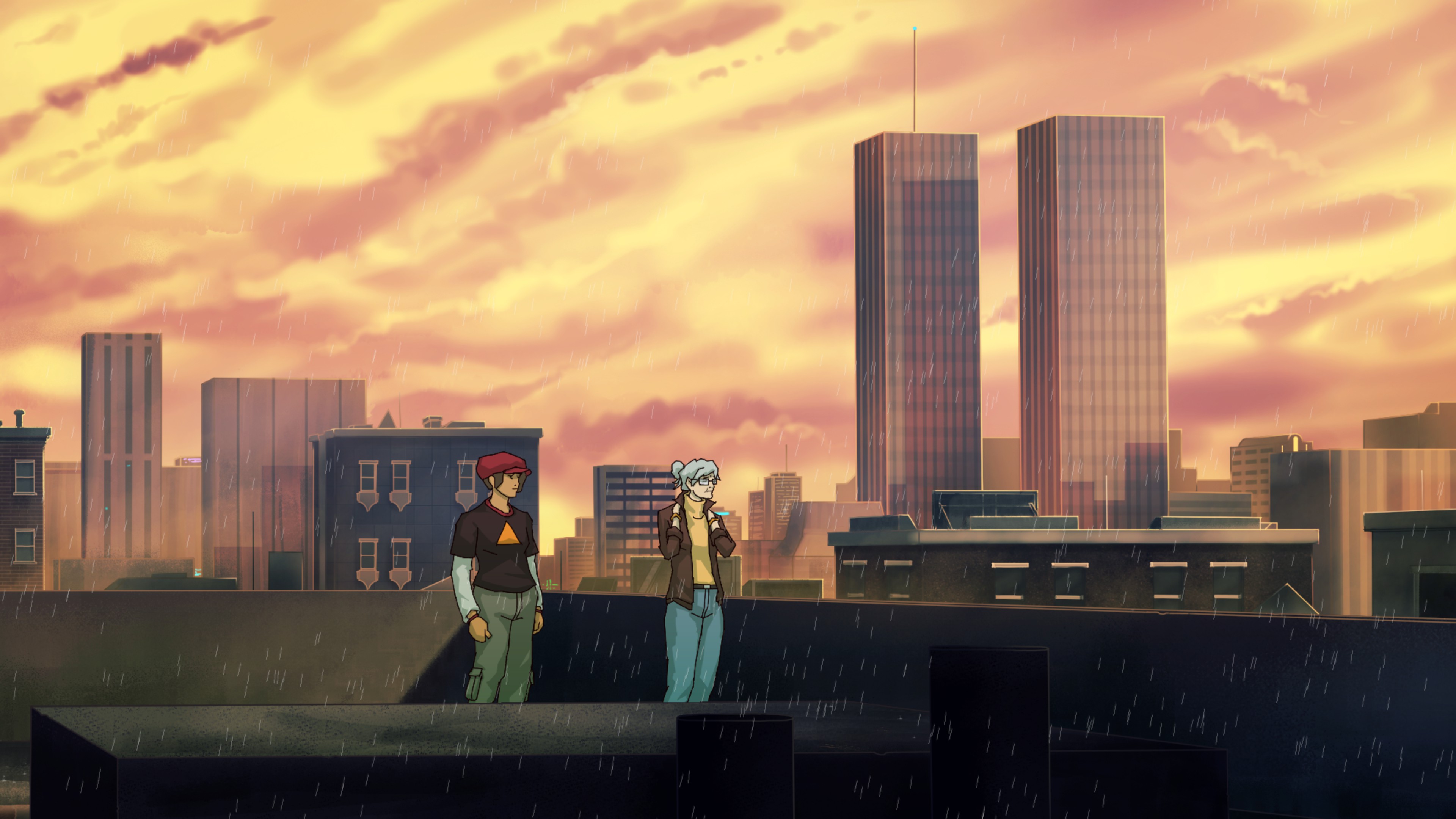Today Theme Hospital is a fiddly management sim, but the daft jokes endure
Checking back in.
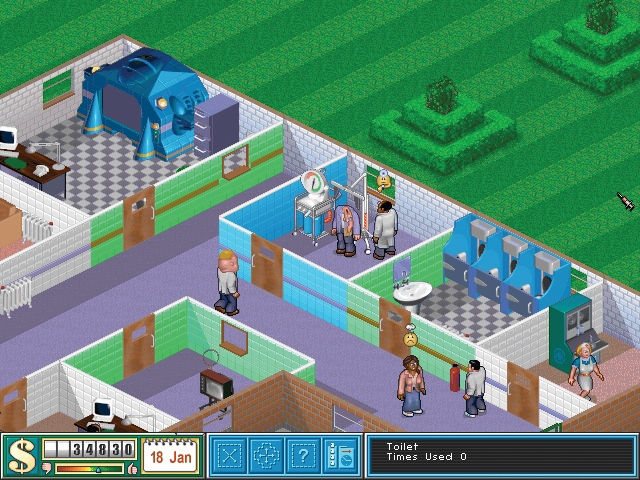
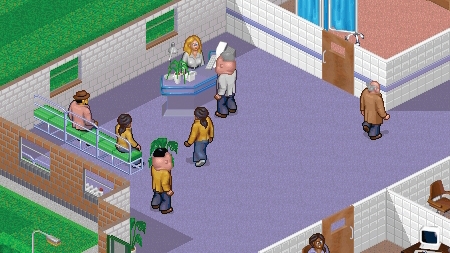
Reinstall invites you to join us in revisiting PC gaming days gone by. Today Chris revisits a Bullfrog classic.
Theme Hospital has been through several stages of life. At launch in 1997 it was a big deal, the successor to theme park—the game that made Bullfrog’s fortune.
Theme Park was an irreverent, colourful management simulator that turned the Guildford studio from a domestic player to an international contender. Theme Hospital adopted Theme Park’s tone—and great swathes of its code—and turned it to a different purpose: the running of a profit-driven British hospital where patients suffer from a variety of comedic, and fictitious, diseases. It was softly irreverent in a way that drew flack from government and the press at the time, but would entirely pass under the radar now.
Then Theme Hospital found a second life as a bargain-bin perennial throughout the low years of the early ’00s. Visit any game shop (remember those?) and there it would be, in a number of different budget imprints. Millions have likely played it. It is kid-friendly but cheeky, lightly strategic but chiefly about having fun with your hospital, its beleaguered staff, and its comedy gadgets. It would run on your parents’ PC. It has been worth a fiver for about 15 years and is still worth a fiver today.
Indeed, it costs about that to pull Theme Hospital down from GOG complete with a DOSBox launcher that bypasses the Windows compatibility issues that plague a lot of games from this era. Brutal but necessary fullscreening of its 640x480 native resolution aside, the process of running Theme Hospital on a modern PC is relatively painless.
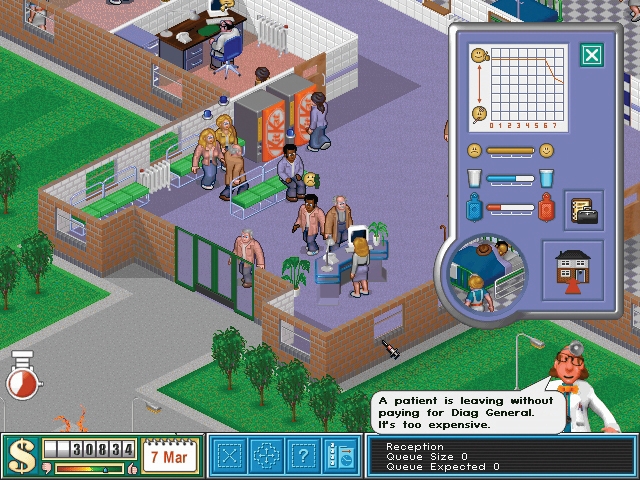
The flashy-for-the-time opening cutscene is a statement of intent. A helicopter arrives to rush a middle aged superstar doctor—who is in the middle of a game of Dungeon Keeper—to his patient. He bursts dramatically through hospital doors, crushing a nurse. He begins to rev his medical chainsaw, but the patient fails his credit check: a button is pushed and a trapdoor opens. The patient falls into darkness, screams, and the game starts.
It’s tempting to try and unpick the politics here but, if anything, Bullfrog was eager to avoid being seen to undermine the practice of running a hospital. Theme Hospital is too British to read as a sendup of the US healthcare system, and too playful to come across as a critique of the management of the NHS. Instead, this is best understood as a comedy management game written and designed by people who watched a lot of comedies like The Fast Show and Red Dwarf—it just happens to have a hospital theme.
Patient growth
Each new hospital begins as an empty shell, with new wings available for purchase depending on the level you’re playing. Your first job is to create a reception area with desk, benches, vending machines, plants and so on. Then you’ll need diagnosis rooms, psychiatrists’ offices, and wards. After that comes treatment: a pharmacy can handle most cases, while certain daft diseases—such as Bloaty Head, or King Complex, which turns people into Elvis—require special treatment facilities. All of this comes at a cost, which is recouped as patients pay for diagnosis and payment.
The biggest gaming news, reviews and hardware deals
Keep up to date with the most important stories and the best deals, as picked by the PC Gamer team.
You need to provide toilets and rest facilities for your staff, consider heating and keep your corridors clean. You can borrow money to raise the necessary funds, or fiddle with hospital policy to boost profits: like forcing patients to get more diagnoses than they actually need, paying every time. You’re being assessed based on how many patients you cure, what proportion of your walk-ins you handle, how much money you make and the overall worth of your hospital. Meet these criteria for a given stage and you’re whisked away onto the next right away. There are random events, epidemics, and a few Easter eggs: you might get tasked with curing a set of priority patients to a time limit or suddenly contend with an equipment-wrecking earthquake. Otherwise, that’s the shape of the game. Build a hospital to spec, watch it run, move on.
You can speed up or slow down time, but you can’t change anything about your hospital while you’re paused. A modern take on this idea would very likely let you do your planning and building in a paused state and then click ‘go’ on your new hospital design: that isn’t the case here. At the beginning of each Theme Hospital level there’s a grace period where you can get up and running, but after that you’re building as you go. If your receptionist is constantly saying that a doctor is needed in the general diagnosis department, then that might be a sign that it’s time to summon one from thin air. If patients are walking out in disgust because you can’t do anything about their grossly-inflated heads, then it might be time to build an extra treatment room on the fly. There’s a sense that you’re always laying the tracks in front of the train, which is about as close to topical satire as Theme Hospital gets.
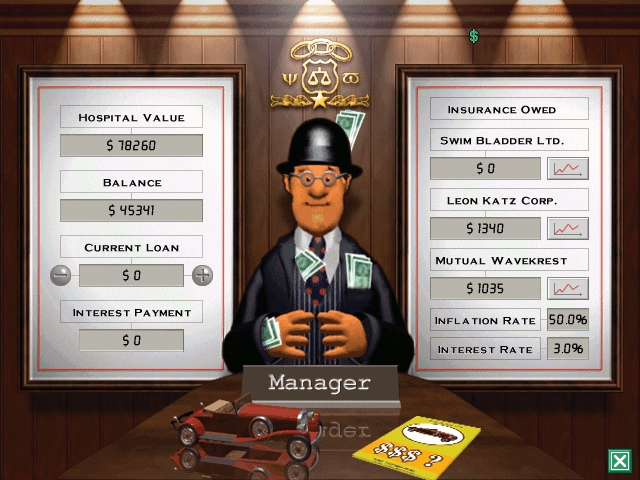
The game hasn’t entirely aged well, otherwise. It was surprising to load the staff menu for the first time and realise that all doctors and janitors are men, while all nurses and receptionists are women. This isn’t a case of the game falling short of modern standards: this was a glaringly shortsighted design decision in 1997, and it’s embarrassing that nobody caught it at the time. It doesn’t mean that you can’t enjoy the game or its humour, but it does highlight why it’s important to be circumspect about your nostalgia.
What endures about Theme Hospital is its sense of fun. It’s a management sim, sure, but it’s also a toybox come to life.
What endures about Theme Hospital is its sense of fun. It’s a management sim, sure, but it’s also a toybox come to life: a little world populated by tiny people where half the enjoyment comes from setting them in motion and watching them go. It’s all in the details: the agonised low-fi straining and plopping sounds that accompany a man doing a poo in your splendid new toilets, or the hearty pop that precedes a patient having their head reinflated.
As a Bullfrog game Theme Hospital is obviously on a continuum with Theme Park, but it’s also a peer of Dungeon Keeper and Syndicate—games that were all about extracting maximal interactivity from an isometrically-viewed environment. In Theme Hospital, a rat infestation might mean hiring more janitors: a typical management sim solution, a matter of matching the need against your balance book. On the other hand, you might hunt across the screen for the rats yourself, batting them from the sky in an impromptu game of Where’s Wally-turnedWhac-a-Mole. Do this enough and you get to visit a bonus stage.
There’s a bit of magic to this that has survived the decades. This is a game that wants to reward your purchase of a powerful, shiny new CD-ROM drive (’00s kids: imagine a fidget spinner that is also a USB stick that you feed into a mouth on the front of your PC). Bullfrog knew what it was doing with a CD by 1997, but this is nonetheless a game from an era when designers were animated by the silly, clever, fun things that improving tech allowed them to do. There’s an inherent playfulness here that is formed at the point where Bullfrog’s studio culture met better, more liberating tools: if Theme Park was the chips-down risk that helped the team build a reputation and allowed Molyneux to sell the studio to EA, then Theme Hospital is the game that happens when EA’s money arrives.
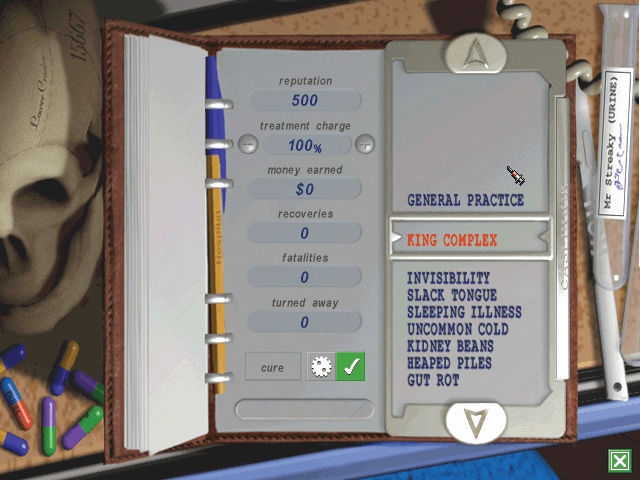
It’s not going to wow you today, of course, but that playful energy remains—and there’s still charm to its pixelated patients and chunky hospital furniture. Stare at any given part of your creation for any given time and you’ll see something to make you smile, whether that’s a patient’s bum sticking out of their backless surgery robe or a janitor coaxing a wilting fern back to life with a watering can and happy slurping sound.
You’d want any successor to this game—Two Point Hospital included—to retain that eagerness to surprise you and make you laugh. Modern management games have different priorities. They’ve gotten better at giving you the power to customise your creations and place more emphasis on creating a sense of attachment. That aspect is curiously missing from Theme Hospital: this is very much a level-based game, with the predefined outlines of each new hospital wing dictating the shape of the puzzle you have to solve.
Clinical imprecision
If you want your theme parks, star empires and sim cities laid out just so then it can be a bit unsettling. Hospital rooms have minimum sizes and they don’t always line up neatly. The ever-ticking clock punishes fiddling and, while a failing hospital might limp on for a decent stretch of time, a successful hospital—one that meets the conditions of the level—will be suddenly and unceremoniously snatched away from you as you’re hurried to the next challenge. It’s a toy, but one with some stringent limits on the ways you get to play with it.
The best way to enjoy Theme Hospital now is to load it up on the easiest difficulty setting. That way you get to play around with making your ideal hospital in your head without worrying about some of the game’s deeper management elements. You can tinker with the cost of specific cures to maximise profits from particularly common ailments, for example, or tweak pay to min-max your staff morale. This is good and necessary from a management game perspective, but if that’s your priority then better games have been released in the last two decades. Come back to Theme Hospital for the jokes, the fun pixel art, the daft little animations, and the excellent fart noises.
Joining in 2011, Chris made his start with PC Gamer turning beautiful trees into magazines, first as a writer and later as deputy editor. Once PCG's reluctant MMO champion , his discovery of Dota 2 in 2012 led him to much darker, stranger places. In 2015, Chris became the editor of PC Gamer Pro, overseeing our online coverage of competitive gaming and esports. He left in 2017, and can be now found making games and recording the Crate & Crowbar podcast.


